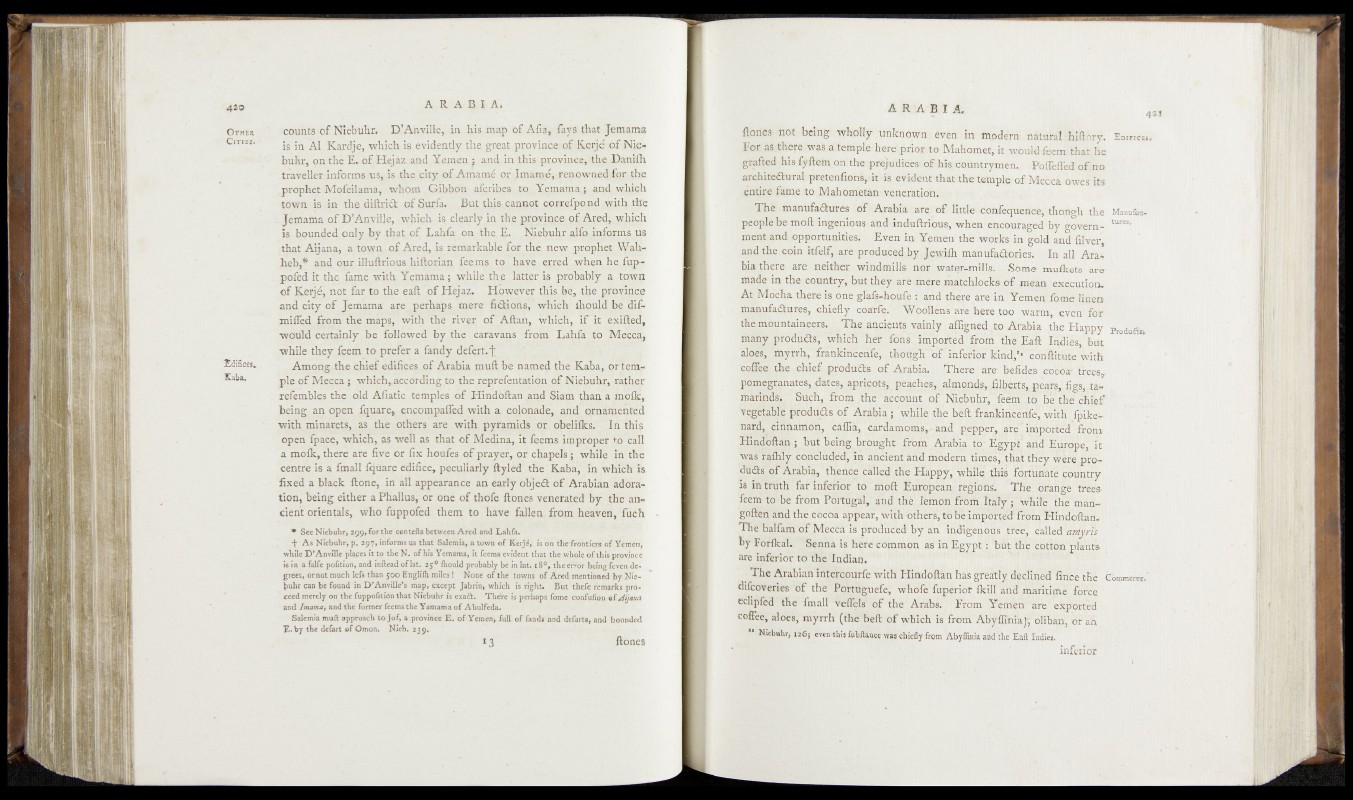
O t h e r
C it ie s .
"Édifices.
Kaba.
counts of Niebuhr. 'D’Anville, in his map of Afia, fays fhat 'Jemama
is in A1 Kardje, which is evidently the, great province of Kerje of Niebuhr,
on the E. of Hejaz. and Yemen : and in this province,;the Danifh
traveller informs us, is the city of Amaine or Imame, renowned for the
prophet Mofeilama, whom Gibbon afcribes to Yemama; and which
town is in the diftri£fc of Surfa, But this-cannot cor-refpond with the
Jemama of D ’Anville, which is clearly in the province of Ared, which
is bounded only by that of Lahfa on 'the E. Niebuhr alfo informs us
that Aijana, a town o f Ared, is remarkable for the new prophet Wah-
heb,* and our illuftrious hiftorian fee ms to have erred when hefup-
pofed it the fame with Yemama; while the latter is probably a town
of Kerje, not far to the eaft , of Hejaz. However this be, the province
and city of Jemama a^e perhaps mere fidtiqns,’ which thopld be jdif-
mifled from the maps, with the river of Allan, wtiidh^ n # ’ej&iiftied,
would certainly . be followed by the caravans from Lahfa to Mecc<j,
while they feem to prefer a fandy defert.f;
Among-the chief edifices of Arabia muft be named the Kafea, or tqm-
pie of Mecca; which^according to,the treprefentation of Njebuhr, rather
refembles the old Afiatic temples of Hindoftan and Siam than, a moftc,
being an open fquare, encompaffed with a^ cdonade, and ornamented
with minarets, as the others are with pyramids or obelifks. In ibis
open fpace, which, as well as that of Medina, it feems, improper to call
a mofk, there are five or fix houfes of prayer, or chapels ; while in the
centre is a fmall fquare edifice, peculiarly ftyled the Kaba, in which is
fixed a black ftone, in all appearance an early objedfc of Arabian adoration,
being either a Phallus, or one of thofe ftones venerated by the ancient
orientals, who fuppofed them to have fallen from heaven, fuch
* See Niebuhr, 299, for the contefts between Ared and Lahfa. '
, • f As Niebuhr, p. 297, informs us that Salemia, a town of Kerjd, is on tlie’frohtiers of Yemen,
while D ’Anville places it to the N. of his Yemama, it feem* evident that the whole of this province
is in a falfe pofition, and in (lead oflat. 2 50 fhould probably be in lat. 18°, the error being feven degrees,
or not much lefs than 500 Englifh miles! None of the towns of Ared mentioned by Niebuhr
can be found in D ’Anville’s map, except Jabrin, which is right. But thefe remarks'proceed
merely on the fuppofitidn that Niebuhr is exaft. There is perhaps fomc coflfufion of Aijana
and Imama, and the former feems the Y amama of Abulfeda.
Salemia muft approach tojof, a province E. of Yemen, full of fands' and defarts, and bounded
E. by the defart of Omon. Nieb. 239.
J3 Hones
Hones not being wholly unknown even in modern natural, hiftory. Edifices,
For as there was a temple here prior to Mahomet, it would feem that he
grafted his jyftempa, the prejudices^.his countrymen. Poffeffed o f no
architedtural prétentions, it is evident that the tetaple- o f Mecca -owes its
. entjré famé .to Mahometan veneration.
The manufadtoes of- Arabia ..are' o f littrle* co'filfequenee^ thojigh the MxnuW.
people be moft ingenious ,anddnduftrimis, when'entemraged by govern- turcsi
ment and-opportunities"., Even in Ygmeuthfe works in gold andfilver,
and the. coin itfelfji^e producedJ^J^ssifh manufactories-. lit all Ata*
Nâ there are neither windmills- nor water-mills.. Some mulkets are
made "in the-, country, hut they ,, ^re mère matchlocks o f mean execution.
AlpVfoc&a. there is qqk glafsrhouM* and.tftei^a'iie ~iö Yemeïlfome linen
màftufadure’s, chiefly coarrfe.^.WèolIl^^re,hero,,töp*warm,,'è v e#Mr-
Iher n o , u n t p i n v a i n l y affigned,to Ara,bia the Happy Pro(lu^ '
manymfodu^ts^ which her font '/imported ’fpom t i l l Eaft Ï iy liïs f but
alpesj^myrïh,' 'frankiricenfe, though Vrinf^lolTtónd^f^orfhitute -with
coffee the chief-p ro d u is o f Arabia. There are heJfdes- êocè‘i “freesr
pomegranates, dates, apricots, peaches* ^alm^d^kêl^ts-nè^ghg^tii-
marmds./'- Sijch^lrom yhe;'account ..of Nrehuhr, y o l e Die chief
vegetable produis o f Arabia ; while. t|e ^frfTrà lîinfltfe,1 with ' fpifcv
uard, cirinatnon, caffia, cardknaoms',^ ^nd peppVr, .are irhporïêçï *■ front
Hind oft an ; but being_brought from A ra b ia® Egyp£J and Europe, it
wasYalhly concluded, in ancient and modem times,',that thVy wèreproh
ducts of Arabia, ' thence called the Happy, while this förtpnate country
is in ttuth far inferiof to moft European.’ régions, ijiefórang'e trees-
feetmto’-be from Pbrtugaif and't fi è, ? lemon Yrom l tpTf*;Cwftile the’man- |
goften and the coc'oa appear, with 'othèrsV to Be im^ftea irhm Hindoftan.
Thë'balfam o f Mecca is produced by an iMigenqys eie, called^a/T^rfl-
by FoiËkal., Senna is here common as id Egypt : ‘bft thVcettônplantk
are inferior tefthe Indian. %
j The Arabian'inïeïcôurfe with Hindoftan has greatly'declined'fanhh the Commerce.'
difeoveries 'o f the PortuguefeJ whole fupèrior Ikilf and maritime“ '
eclipfed the fmall veffâs of the Arabs. Frdm ïediert are ekp‘orted
coffee, aloes, myrrh (thé beft o f which îh'‘frôfti'. Ahyfîhiik)f'olibkn, or an,
"* Niebuhr, 126; even this fiibftance was chiefly from Abyffinia and the Eaft Indies. ,
inferior